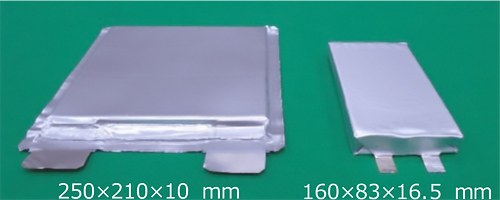Hard-flammability of batteries–using less-volatile electrolytes–with battery capacity of 130 Wh and energy density of 600 Wh/L was demonstrated
December 6, 2019
Hitachi, Ltd. today announced the development of a laminate-type lithium-ion battery*1 (hereafter referred to as "LIB") utilizing a less volatile electrolyte material. The LIB developed provides an energy density of 600 Wh/L while assuring a high level of safety. The resultant battery capacity is thus 130 Wh, while the size of the LIB is 60% less than that of our previous model. The developed laminate-type LIB was tested on the basis of safety standard IEC62660 (by, for example, crush tests*2 and overcharge tests*3), and the test results demonstrated that it would not ignite under such abnormal conditions. This battery technology makes it possible to (i) effectively utilize the interior space of a car equipped with LIBs and (ii) install power sources for adjusting the demand/supply balance of renewable energy in a small space.

Figure 1: Conventional laminated LIB (left) and developed LIB (130 Wh) (right)
A laminated LIB with battery capacity of 130 Wh, energy density of 600 Wh/L, and 60% smaller size than a conventional LIB [see Figs. 1(a) and (b)] was developed, and a safety-standard test based on IEC62660 revealed that the developed LIB does not ignite under abnormal operations.
A part of the results from this work were announced at the 236th Electrochemical Society Meeting (in Atlanta, USA from October 13, 2019) and the 3rd International Advanced Automotive Battery Conference (in Chiba, Japan from October 28, 2019).
In conventional laminated LIB utilizing organic electrolytes, if the volatility of the electrolyte is high, this can lead to an increase in internal pressure which may cause the LIB to burst and electrolytes to leak, increasing the risk of poisoning and ignition. By improving a non-volatile electrolyte*4 (developed in collaborative research with Tohoku University) by utilizing simulation-analysis technology and devising a composition that achieves both low volatility and good charge and discharge reaction, Hitachi has achieved a volatilization temperature*5 higher than 100℃ and suppressed volume expansion (during a simulating test of battery expansion*6) during heating.
A conventional LIB (Fig. 2(a)) has a laminated sealing part around its outer periphery for maintaining airtightness. However, this part represents surplus space that is not involved in power storage, and that surplus space is a factor in lowering energy density. By adopting the non-volatile electrolyte described in Section 1, the rise in internal pressure can be suppressed, and the laminated bonding part can be simplified. This improved configuration made it possible to configure the LIB structure with high energy density (Fig. 2 (b)).

Fig. 2: Schematic diagram of battery structures: (a) conventional LIB and (b) developed LIB
Aiming to enhancing energy density, we investigated thinning of the electrolyte layer that provides insulation between the positive and negative electrodes. Excessive thinning of the electrolyte increases the probability of heat generation due to a short circuit between the electrodes, which may cause ignition and lead to decreased safety. We therefore modeled the mechanism of heat generation and ignition, calculated the optimum thickness of the electrolyte layer, and devised a battery design that increases energy density while ensuring high safety level.
As a result of the above-described structure, the developed LIB’s energy density is 600 Wh/L, namely, 50% higher than our previous model, and its size is 60% smaller. The developed LIB was tested in accordance with safety standard IEC 62660, and the safety test demonstrated that it does not ignite under abnormal conditions. We expect this LIB technology to reduce the number of components (such as reinforcing materials and cooling mechanisms) required to ensure the safety demanded of LIB systems using organic electrolytes, and that reduction will make battery systems more compact and improve their price competitiveness.
Part of this development was carried out as part of a contracted project called “Innovative Science and Technology Initiative for Security” of the Acquisition, Technology & Logistics Agency (ATLA).
For more information, use the enquiry form below to contact the Research & Development Group, Hitachi, Ltd. Please make sure to include the title of the article.